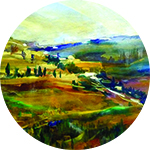The Blessing of Bread

Taking challah is practical, material — and a spiritual tether

T
he smell ushers in Shabbos Kodesh each week. The taste is Shabbos delight. Kneading, braiding, topping, the hands of Jewish women usher in the sanctity of Shabbos through baking challah. In addition to our own tables, we welcome the mitzvah of taking challah with parties, events, join-for-zechus endeavors, and more. This mitzvah has been passed through our mothers and grandmothers in a chain going back to Sarah Imeinu.
In this week’s parshah, the world mourns along with Avraham after the loss of Sarah Imeinu. While he struggles to bury her with dignity, Avraham is also left to assume the responsibility of marrying off their son, Yitzchak. When Rivkah is brought into his mother’s tent, Yitzchak is comforted, as the pasuk states (Bereishis 24:67): “Vaye’ehaveha, vayinacheim Yitzchak acharei imo — And he loved her, and Yitzchak was comforted over [the loss of] his mother.”
Rashi explains why Yitzchak was comforted when Rivkah entered the tent. He quotes the midrash: “As long Sarah was alive, the candles were lit from Erev Shabbos to Erev Shabbos, there was brachah in her dough, and a cloud hovered over her tent. When Sarah died, these miracles dissipated, and when Rivka entered the tent, they returned (Bereishis Rabbah 60:16).
Of the three miracles (the brachah in the candles, dough, and cloud), the brachah b’isah, blessing in the dough, is clearly the most material and practical. In his commentary on the parshah, Rav Pincus explains that the brachah in the dough of our Imahos is an inherent satisfaction in the material status of her home. In the perfect homes of our Imahos, nothing was extraneous; everything they had was utilized to its ultimate enjoyment and purpose. Can we even imagine a home where there is no waste and everything that is there is consumed to perfection? No clothing worn sometimes or never, no food rotting in the back of the fridge that we forgot about.
Blessing Bread
Bread, dough, represents money. It’s often used as a symbol of material gains because of the toil we must go through to produce it. As they say, “no pain, no gain.” The converse assumption is that once you’ve sweated and pushed, your profits are yours to enjoy.
Rav Tzaddok HaKohein points out that 11 of our 39 melachos of Shabbos have to do with the process of making bread. There is so much we need to do to make bread happen, from planting the wheat to milling the flour to kneading the dough. It’s not hard to delude ourselves into thinking that after all that pain, we are the artisans — we made the bread!
Yet the brachah on bread is “Hamotzi lechem min ha’aretz.” When we make this blessing, the loftiest of all the blessings on food, we are proudly proclaiming Hashem as the One Who “brings the bread out of the earth.” We dispel any self-aggrandizing ideas of the supremacy of our parts in the process, affirming that it is only the “Motzi Lechem min Ha’aretz” who brings the bread to our table.
Rav Tzaddok HaKohein further points out that while the farmer is intrinsically aware that his crops grow but by the mercy of HaKadosh Baruch Hu, the ploughing, harvesting, and threshing may mislead him into thinking, “It is my strength and the brawn of my hands that brought me to this accomplishment.” And even for those who are not farmers, the end product — bread — is made from flour, yeast, salt, and other ingredients that don’t look like anything until our hands form them into something.
Yet when we make the brachah before and after eating a meal with bread, we declare the opposite. Before we eat, we affirm that it is Hashem Who brings bread from the earth. In Bircas Hamazon we affirm, “Hazan es ha’olam kulo b’tuvo b’chein b’chesed, uv’rachamim.” Hashem alone sustains the world with sensitivity, kindness, and compassion.
Connection to the Mikdash
My mother, zol zein gezunt, wanted to teach my sisters and me what it means to be a bas mitzvah. As we reached this milestone, she sought a mitzvah we could do that would represent our new responsibility, and she’d either buy a new utensil for us to toivel or have us take challah.
The mitzvah of taking challah is unique: It connects us to the mitzvah of giving a portion of our bread to the Kohein in the times of the Beis Hamikdash. Because the Kohanim were busy with the communal avodah in the Beis Hamikdash, they had no means of providing for their families. Those who baked bread would set aside a portion of their dough for them so they could continue in their holy work. Today, though the Beis Hamikdash no longer stands, this mitzvah remains (although we burn the dough we separate as opposed to offering it to a Kohein).
Anyone who bakes bread, male or female, at home or commercially in a bakery, pizza shop, or anywhere else, is obligated in the mitzvah of hafrashas challah. Yet this mitzvah seems to be most often relegated to the Jewish woman’s kitchen. It is interesting to note that among the mitzvos that the Kli Yakar mentions the women coveted in the land of Eretz Yisrael (parshas Pinchas) is the one of challah.
In his commentary on parshas Shelach, Rav Hirsch mentions the Gemara in Chulin 11, which states: “Whoever says ‘My whole vineyard is orlah and my entire dough is challah’ did not say anything.” Challah is only challah if one separates it.
There is a deeper message here, one that speaks of Hashem’s love for each individual: Do not think that Hashem is only interested in the Kohein, the Bais Hamikdash, gedolim, and the like. No! Hashem needs my avodah, here in my home. By taking challah, we turn our kitchens into a mikdash me’at, expressing our remembrance and longing for Hashem’s Home. Just as we took challah when we had the Beis Hamikdash, from my home in galus, too, I will serve You with joy!
Rebbetzin Aviva Feiner is the rebbetzin of Far Rockaway’s Congregation Kneseth Israel (The White Shul) as well as a mechaneches in TAG and a visiting lecturer at Stern College.
(Originally featured in Family First, Issue 818)
Oops! We could not locate your form.





